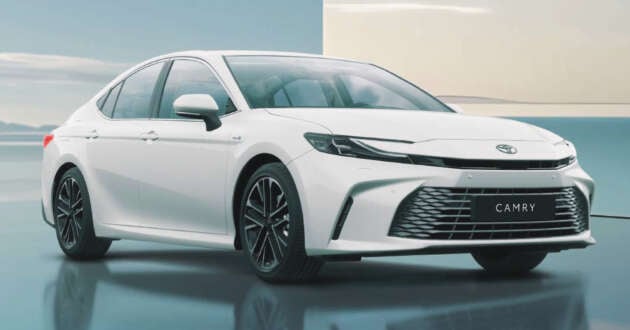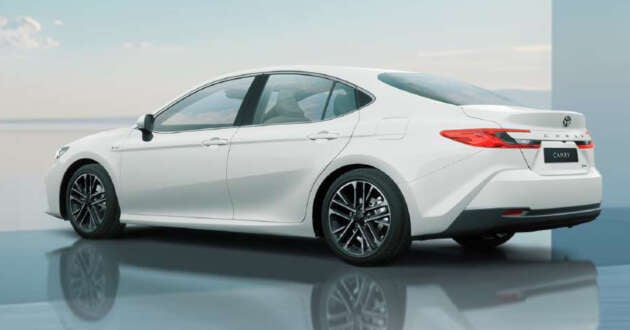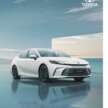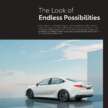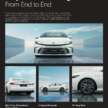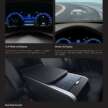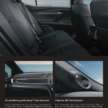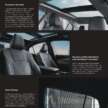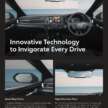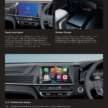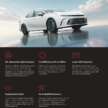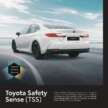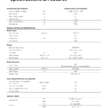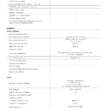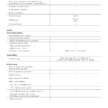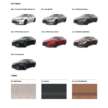Following the launch of the ninth-generation (XV80) Toyota Camry Hybrid at this month’s Kuala Lumpur International Mobility Show (KLIMS), UMW Toyota Motor has now introduced the non-hybrid variant of the D-segment sedan. The new 2.5V variant retails for RM221,800 on-the-road without insurance, which is RM27,000 less than the hybrid version known as the 2.5 HEV that sells for RM248,800.
Both variants are available with the same colour options, namely Emotional Red 2, Platinum White Pearl Mica, Previous Metal, Attitude Black Mica, Cement Grey Metallic and Dark Blue Mica. A five-year, unlimited-mileage also comes standard, with the hybrid gaining an additional eight-year, unlimited-mileage warranty for its hybrid components.
The 2.5V is powered by Toyota’s Dynamic Force engine, specifically the A25A-FKS 2.5 litre naturally-aspirated inline-four that serves up 204 PS (201 hp or 150 kW) at 6,600 rpm and 246 Nm of torque from 4,200 to 5,000 rpm. Drive is sent to the front wheels via a Direct Shift eight-speed automatic transmission, which enables a 0-100 km/h time of 8.9 seconds and top speed of 210 km/h.
By comparison, the 2.5 HEV uses a hybridised version of the Dynamic Force mill called the A25A-FXS, which has the same displacement but serves up 188 PS (185 hp or 138 kW) at 6,000 rpm and 221 Nm from 3,600 to 5,200 rpm.
This is augmented by a 1VM electric motor rated at 136 PS (134 hp or 100 kW) and 208 Nm for a total system output of 230 PS (227 hp or 169 kW) for a reduced century sprint time of 7.2 seconds but the top speed is less at 180 km/h. The 2.5 HEV is also paired with an E-CVT (electronic continuously variable transmission) instead of an eight-speed auto gearbox, and it comes with selectable drive modes (Eco, Normal, Sport and EV).
In addition to the hybrid components, the 2.5V differs from the 2.5 HEV by having a kerb weight of 1,565 kg, which is 80 kg less than the hybrid. It also has a larger fuel tank capacity of 60 litres compared to the hybrid’s 50 litres. The claimed fuel consumption is also better with the hybrid at 4 l/100 km instead of the 2.5V’s 6.6 l/100 km.
As for equipment, the 2.5V comes with 18-inch wheels (235/45 profile tyres), automatic bi-LED headlamps with LED turn signals, LED daytime running lights, front and rear LED fog lamps, LED combination taillights, rain-sensing wipers, a 12.3-inch digital instrument cluster, a head-up display, a 12.3-inch touchscreen infotainment system, wireless Apple CarPlay and wired Android Auto support, a nine-speaker JBL sound system and vehicle telematics.
These features are shared with the 2.5 HEV, as are eight-way powered front seats that have a memory function for the driver’s seat and a shoulder switch for the front passenger, rear air vents, black leather seat upholstery, a power adjustable steering wheel, an electrochromic rear-view mirror, front and rear dashcams and a wireless charging pad.
The Toyota Safety Sense suite is identical too and includes systems such as autonomous emergency warning, all-speed adaptive cruise control, lane departure alert, lane tracing assist, automatic high beam and road sign assist. There are also seven airbags, VSC, traction control, ABS, EBD, brake assist, hill start assist, a panoramic view monitor, blind spot monitoring, rear cross traffic alert with braking support, emergency stop signal as well as front and rear parking sensors.

So, what are you missing out by not paying more for the hybrid? Well, the 2.5V doesn’t get a panoramic sunroof and shark fin radio antenna, the latter integrated into the rear windscreen instead. Additionally, it’s only a dual-zone climate system instead of a tri-zone and the rear seats do not come with a power reclining function and dedicated control panel. You do get a sunglass holder which the hybrid misses out on, likely to accommodate the sunroof controls.
Given the similarities and differences, which of the two Camry variants would you go for? Share your thoughts with us in the comments below.
GALLERY: 2025 Toyota Camry brochure and price list





































































































































































































































































































































































